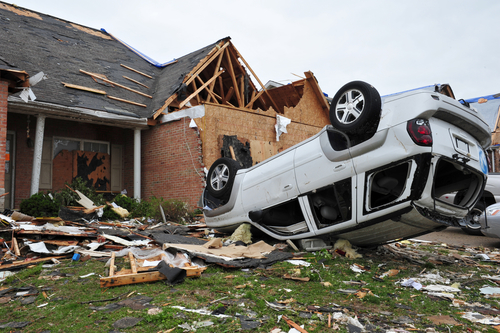
|
Cleanup recommendations for specific weather events are outlined below.
Storm and Tornado Cleanup
Storm and tornado cleanup work can involve hazards relating to restoring electricity, communications, water, and services. Other hazards relate to demolition activities, cleaning up debris, roadway and bridge repair, hazardous waste operations, and tree trimming. To keep workers performing these operations safe, share these tips:
- Assume all power lines are live unless you know otherwise, and keep a safe distance (at least 10 feet) away from them.
- Wear proper clothing when walking on or near debris, including boots and gloves.
- Be careful of sharp objects, such as nails and broken glass.
- Take proper safety precautions when operating generators, chain saws, or other power tools.
- Monitor local radio or television stations for emergency information, and be aware of possible structural, electrical, or gas-leak hazards.
- Exercise caution when entering any structure that has been damaged.
Safety 101 is a comprehensive handbook with everything you need to establish and run a workplace safety program, so you can ensure your company is both safe to work in and compliant with OSHA’s standards. Learn more today!
Flood Cleanup
Flood cleanup also poses unique challenges, including dam and levee repair, removal of floodwater from structures, and repairing downed electrical wires in standing water. Those engaged in cleanup activities should be aware of the hazards associated with floodwaters, including rapidly rising water, strong currents, and more. Share these important safety tips with flood cleanup workers:
- Exercise caution when driving during flood conditions. Do not try to cross flooded roadways if you do not know the depth of the water.
- Stay away from flooded areas that may be in contact with downed energized power lines or other sources of electricity.
The handbook identifies more than 60 health and safety challenges that companies face, and each chapter outlines step-by-step how to establish and implement a workplace safety program that addresses these challenges. Learn more here!
- Standing or working in water colder than 75 degrees Fahrenheit can result in hypothermia, so be sure to wear proper clothing for cold, wet, and windy conditions.
- Wear gloves, boots, and other appropriate protective clothing, and exercise good hygiene practices to protect yourself from potential chemical or biological hazards that may be present in floodwater.
- Workers near floodwater should not work alone and should wear Coast Guard-approved personal flotation devices (PFDs) to protect against drowning hazards.
